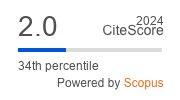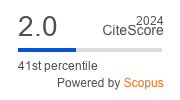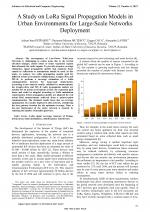| 4/2021 - 7 |
A Study on LoRa Signal Propagation Models in Urban Environments for Large-scale Networks DeploymentPETRARIU, A. I. |
| Extra paper information in |
| Click to see author's profile in |
| Download PDF |
Author keywords
LoRa signal coverage, Internet of Things, urban areas, chirp modulation, radiofrequency interference
References keywords
lora(11), internet(8), propagation(6), technology(5), environment(5), communication(5), systems(4), power(4), networks(4), evaluation(4)
Blue keywords are present in both the references section and the paper title.
About this article
Date of Publication: 2021-11-30
Volume 21, Issue 4, Year 2021, On page(s): 61 - 68
ISSN: 1582-7445, e-ISSN: 1844-7600
Digital Object Identifier: 10.4316/AECE.2021.04007
Web of Science Accession Number: 000725107100007
SCOPUS ID: 85122257608
Abstract
The development of Low-Power Wide-Area Networks is challenging in urban areas due to the terrain elevation changes, clutter losses or dense vegetation regions that attenuate the radio signals. To provide accurate coverage estimation, signal propagation models that integrate losses caused by reflections or attenuations should be used. In this study, we analyze two radio propagation models used for different urban environment configurations, Longley-Rice and ITU-R, to perform a coverage estimation of a LoRa communication network for large-scale deployments. According to our analysis results, validated by measurements, the Longley-Rice and ITU-R radio propagation models are suitable for an urban environment as they use vegetation path losses and can be adapted according to LoRa modulation requirements. Those propagation models are adjusted for real urban field measurements achieved from a point-to-point communication. The obtained results focus also on coverage optimization of a locally deployed LoRa network, considering the best gateway location for the optimum coverage. Thus, a low-cost deployment of the entire network is ensured by reducing the number of installed gateways. |
| References | | | Cited By |
Web of Science® Times Cited: 6 [View]
View record in Web of Science® [View]
View Related Records® [View]
Updated today
SCOPUS® Times Cited: 10
View record in SCOPUS® [Free preview]
View citations in SCOPUS® [Free preview]
[1] Beacon Success Rate versus Gateway Density in Sub-GHz Sensor Networks, Can, Başak, Karaoğlu, Bora, Potta, Srikar, Zhang, Franklin, Balanuta, Artur, Gencel, Muhammed Faruk, Bhat, Uttam, Huang, Johnny, Patankar, Pooja, Makharia, Shruti, Suryanarayanan, Radhakrishnan, Kandhalu, Arvind, Krishnamurthy Vijaya Shankar, Vinay Sagar, Sensors, ISSN 1424-8220, Issue 23, Volume 23, 2023.
Digital Object Identifier: 10.3390/s23239530 [CrossRef]
[2] Internet of Things Concept in the Context of the COVID-19 Pandemic: A Multi-Sensor Application Design, Lavric, Alexandru, Petrariu, Adrian I., Mutescu, Partemie-Marian, Coca, Eugen, Popa, Valentin, Sensors, ISSN 1424-8220, Issue 2, Volume 22, 2022.
Digital Object Identifier: 10.3390/s22020503 [CrossRef]
[3] A Critical Review of the Propagation Models Employed in LoRa Systems, Azevedo, Joaquim Amândio, Mendonça, Fábio, Sensors, ISSN 1424-8220, Issue 12, Volume 24, 2024.
Digital Object Identifier: 10.3390/s24123877 [CrossRef]
[4] Technology Assessment for LoRaWAN-Based Time-Limited Smart Parking: A Case Study, Pous-Sabadí, Carles, Meléndez, Joaquim, I Del Olmo, Ricard Casas, Trigo Peinado, Jordi, IEEE Access, ISSN 2169-3536, Issue , 2024.
Digital Object Identifier: 10.1109/ACCESS.2024.3484758 [CrossRef]
[5] Smart marina: concept of stereovision based berthing aid system, Mostarac, Petar, Kahlina, Leon, Janković, Jasna, Ilić, Željko, Šišul, Gordan, Šala, Alan, 2023 4th International Conference on Smart Grid Metrology (SMAGRIMET), ISBN 979-8-3503-2359-7, 2023.
Digital Object Identifier: 10.1109/SMAGRIMET58412.2023.10128656 [CrossRef]
[6] LoRaMeter: Signal Mapping in LoRa Networks, Zobel, Julian, Frommelt, Paul, Laufenberg, Lukas, Fayard, Régis, Wehrstein, Lukas, Kundel, Ralf, Steinmetz, Ralf, 2023 International Conference on Software, Telecommunications and Computer Networks (SoftCOM), ISBN , 2023.
Digital Object Identifier: 10.23919/SoftCOM58365.2023.10271678 [CrossRef]
[7] LoRaWAN Infrastructure for Urban Waste Management: A Simulation Study, de Almeida, Lahis Gomes, de Campos, Marianna Gois, Borin, Juliana Freitag, 2023 IEEE 9th World Forum on Internet of Things (WF-IoT), ISBN 979-8-3503-1161-7, 2023.
Digital Object Identifier: 10.1109/WF-IoT58464.2023.10539568 [CrossRef]
[8] Performance Evaluation of the Dragino DLOS8N and Four-Faith F8L10GW LoRaWAN Gateways in an Urban Scenario, Graha, Reynaldhi Tryana, Setiawan, Raihan Raditya, Fakhrurroja, Hanif, Meylani, Linda, Pramesti, Dita, 2024 International Conference on Intelligent Cybernetics Technology & Applications (ICICyTA), ISBN 979-8-3315-0649-0, 2024.
Digital Object Identifier: 10.1109/ICICYTA64807.2024.10913243 [CrossRef]
Disclaimer: All information displayed above was retrieved by using remote connections to respective databases. For the best user experience, we update all data by using background processes, and use caches in order to reduce the load on the servers we retrieve the information from. As we have no control on the availability of the database servers and sometimes the Internet connectivity may be affected, we do not guarantee the information is correct or complete. For the most accurate data, please always consult the database sites directly. Some external links require authentication or an institutional subscription.
Web of Science® is a registered trademark of Clarivate Analytics, Scopus® is a registered trademark of Elsevier B.V., other product names, company names, brand names, trademarks and logos are the property of their respective owners.
Faculty of Electrical Engineering and Computer Science
Stefan cel Mare University of Suceava, Romania
All rights reserved: Advances in Electrical and Computer Engineering is a registered trademark of the Stefan cel Mare University of Suceava. No part of this publication may be reproduced, stored in a retrieval system, photocopied, recorded or archived, without the written permission from the Editor. When authors submit their papers for publication, they agree that the copyright for their article be transferred to the Faculty of Electrical Engineering and Computer Science, Stefan cel Mare University of Suceava, Romania, if and only if the articles are accepted for publication. The copyright covers the exclusive rights to reproduce and distribute the article, including reprints and translations.
Permission for other use: The copyright owner's consent does not extend to copying for general distribution, for promotion, for creating new works, or for resale. Specific written permission must be obtained from the Editor for such copying. Direct linking to files hosted on this website is strictly prohibited.
Disclaimer: Whilst every effort is made by the publishers and editorial board to see that no inaccurate or misleading data, opinions or statements appear in this journal, they wish to make it clear that all information and opinions formulated in the articles, as well as linguistic accuracy, are the sole responsibility of the author.



